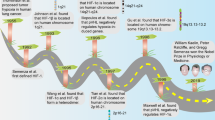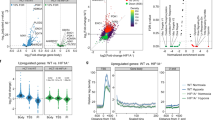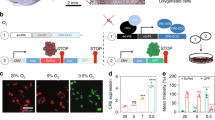Abstract
Solid tumors with areas of low oxygen tension (hypoxia) have a poor prognosis, as celts in this environment often survive radiation and chemotherapy. In this report we describe how this hypoxic environment can be used to activate heterologous gene expression driven by a hypoxia-responsive element (HRE), which interacts with the transcriptional complex hypoxia-inducible factor-1 (HIF-1). Our results demonstrate that the HIF-1/HRE system of gene regulation is active in hypoxic tumor cells and show the potential of exploiting tumor-specific conditions for the targeted expression of diagnostic or therapeutic genes in cancer therapy.
This is a preview of subscription content, access via your institution
Access options
Subscribe to this journal
Receive 12 print issues and online access
$209.00 per year
only $17.42 per issue
Buy this article
- Purchase on Springer Link
- Instant access to full article PDF
Prices may be subject to local taxes which are calculated during checkout
Similar content being viewed by others
References
Kasahara, N., Dozy, A. & Kan, Y. Tissue-specific targeting of retroviral vectors through ligand-receptor interactions. Science 266, 1373–1376 (1994).
Manome, Y., Abe, M., Hagen, M., Fine, H. & Kufe, D. Enhancer sequences of the DF3 gene regulate expression of the herpes simplex virus thymidine kinase gene. Cancer Res. 54, 5408–5413 (1994).
Hallahan, D.E. et al. Spatial and temporal control of gene therapy using ionizing radiation. Nature Med. 1, 786–791 (1995).
Folkman, J. What is the evidence that tumors are angiogenesis dependent? J. Natl. Cancer Inst. 82, 4–6 (1989).
Vaupel, P.W. Oxygenation of solid tumors. in Drug Resistance in Oncology. (Teicher, B.A., ed.) 53–85 (Marcel Dekker, New York, 1993).
Hoeckel, M., Schlenger, K., Mitze, M., Schaeffer, U. & Vaupel, P. Hypoxia and radiation response in human tumors. Semin. Radiat. Oncol. 6, 1–8 (1996).
Bunn, H.F. & Poyton, R.O. Oxygen sensing and molecular adaptation to hypoxia. Physiol. Rev. 76, 839–885 (1996).
Dachs, G.U. & Stratford, I.J. The molecular response of mammalian Cells to hypoxia and the potential for exploitation in cancer therapy. Br. J. Cancer 74, S126–132 (1996).
Wang, G.L. & Semenza, C.L. General involvement of hypoxia-inducible factor-1 in transcriptional response to hypoxia. Proc. Natl. Acad. Sd. USA 90, 4304–4308 (1993).
Wang, G.L., Jiang, B.H., Rue, E.A. & Semenza, G.L. Hypoxia-inducible factor 1 is a basic-helix-loop-helix-PAS heterodimer regulated by Cellular O2 tension. Proc. Natl. Acad. Sd. USA 92, 5510–5514 (1995).
Firth, J.D., Ebert, B.L., Pugh, C.W. & Ratcliffe, P.J. Oxygen regulated elements in the phosphoglycerate kinase-1 and lactate dehydrogenase A genes: Similarities with the erythropoietin 3′ enhancer. Proc. Natl. Acad. Sd. USA 91, 6496–6500 (1994).
Poon, M.A. et al. Biochemical modulation of 5-fluorouracil Ñ evidence of significant improvement of survival and quality of life in patients with advanced colorectal carcinoma. J. din. Oncol. 7, 1407–1418 (1989).
Mullen, C.A., Kilstrup, M. & Blaese, R.M. Transfer of the bacterial gene for cytosine deaminase to mammalian Cells confers lethal sensitivity to 5-fluorocytosine: a negative selection system. Proc. Natl. Acad. Sd. USA 89, 33–37 (1992).
Olive, P.L. Detection of hypoxia by measurement of DNA damage in individual Cells from spheroid and murine tumors exposed to bioreductive drugs. II. RSU1069. Br. J. Cancer 71, 537–542 (1995).
Adams, G.E., Ahmed, I., Sheldon, P.W. & Stratford, I.J. Radiation sensitization and chemopotentiation: RSU-1069, a compound more efficient than misonidazole in vitro and in vivo. Br. J. Cancer 49, 571–577 (1984).
Connors, T.A. The choice of prodrugs for gene directed enzyme prodrug therapy of cancer. Gene Ther. 2, 702–709 (1995).
Maxwell, P.H., Pugh, C.W. & Ratcliffe, P.J. Inducible expression of the erythropoietin 3′ enhancer in multiple Cell lines: Evidence for a widespread oxygen-sensing mechanism. Proc. Natl. Acad. Sci. USA 90, 2423–2427 (1993).
Pugh, C.W., Ebert, B.L., Ebrahim, O. & Ratcliffe, P.J. Characterization of functional domains within the mouse erythropoietin 3′ enhancer conveying oxygen regulated responses different Cell-lines. Biochim. Biophys. Acta 1217, 297–306 (1994).
Levy, A.P., Levy, N.S., Wegner, S. & Goldberg, M.A. Transcriptional regulation of the rat vascular endothelial growth factor gene by hypoxia. J. Biol. Chem. 270, 13333–13340 (1995).
Shweiki, D., Itin, A., Soffer, D. & Keshet, E. Vascular endothelial growth factor induced by hypoxia may mediate hypoxia-initiated angiogenesis. Nature 359, 843–845 (1992).
Stein, I., Neeman, M., Shweiki, D., Itin, A. & Keshet, E. Stabilization of vascular endothelial growth factor mRNA by hypoxia and hypoglycemia and co-regulation with other ischemia-induced genes. Mol. Cell. Biol. 15, 5363–5368 (1995).
Workman, P. & Stratford, I.J. The experimental development of bioreductive drugs and their role in cancer therapy. Cancer Metastasis Rev. 12, 73–82 (1993).
Moulder, J.E., Dutreix, J., Rockwell, S. & Siemann, D.W. Applicability of animal tumor data to cancer-therapy in humans. Int. J. Rod. Oncol. Biol. Phys. 14, 913–927 (1988).
Chaplin, D.J. & Hill, S.A. Temporal heterogeneity in microregional erythrocyte flux in experimental solid tumors. Br. J. Cancer 71, 1210–1213 (1995).
Watling, D. et al. Complementation by the protein tyrosine kinase JAK2 of a mutant Cell line defective in the interferon-γ (signal transduction pathway. Nature 366, 166–170 (1993)
Andersen, L., Kilstrup, M. & Neuhard, J., Pyrimidine, purine and nitrogen control of CD synthesis in Escherichia coli K12: Involvement of the glnLG and the purR genes in the regulation of codA expression. Arch. Microbiol. 152, 115–118 (1989).
Stratford, I.J. & Stephens, M.A. The differential hypoxic cytotoxicity of bioreductive agents determined in vitro by the MTT assay. Int. J. Radiat. Oncol. Biol. Phys. 16, 973–976 (1989).
Author information
Authors and Affiliations
Rights and permissions
About this article
Cite this article
Dachs, G., Patterson, A., Firth, J. et al. Targeting gene expression to hypoxic tumor cells. Nat Med 3, 515–520 (1997). https://doi.org/10.1038/nm0597-515
Received:
Accepted:
Issue Date:
DOI: https://doi.org/10.1038/nm0597-515
This article is cited by
-
Clinicopathological and prognostic value of hypoxia-inducible factor-1α in breast cancer: a meta-analysis including 5177 patients
Clinical and Translational Oncology (2020)
-
Clinicopathological and prognostic value of hypoxia-inducible factor-1α in patients with bone tumor: a systematic review and meta-analysis
Journal of Orthopaedic Surgery and Research (2019)
-
A hypoxia- and telomerase-responsive oncolytic adenovirus expressing secretable trimeric TRAIL triggers tumour-specific apoptosis and promotes viral dispersion in TRAIL-resistant glioblastoma
Scientific Reports (2018)
-
Redox homeostasis protects mitochondria through accelerating ROS conversion to enhance hypoxia resistance in cancer cells
Scientific Reports (2016)
-
Hypoxia-Sensitive Materials for Biomedical Applications
Annals of Biomedical Engineering (2016)



